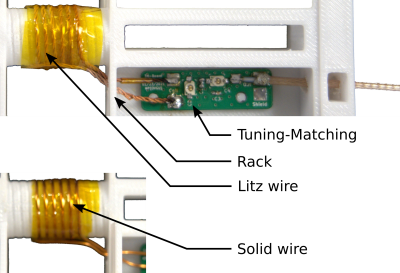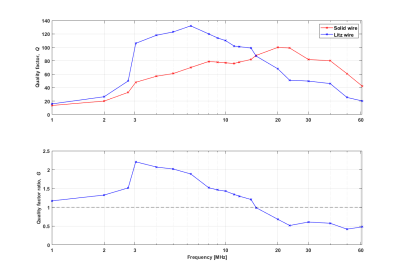1899
Application of Litz Wires in MRI Coil Design up to 15 MHz1Research Campus STIMULATE, Otto-von-Guericke University, Magdeburg, Germany, 2Institute for Medical Engineering, Otto-von-Guericke University, Magdeburg, Germany, 3Department for Biomedical Magnetic Resonance, Otto-von-Guericke University, Magdeburg, Germany
Synopsis
The use of litz wire in their optimized frequency range can provide increased efficiency of high-frequency coils and lead to higher SNR in MR measurements. This work experimentally explores the added value of such a litz wire using equivalent solenoid coils in the range of 1 to 61 MHz. An improvement could be measured up to a frequency of 15 MHz, whereas the maximum effectiveness of the investigated wire was at 3 MHz. In addition, the SNR gain was validated in agreement on an 0.26 T MR system by comparing 1H FID signals.
Introduction
In radio frequency (RF) coil design for magnetic resonance imaging (MRI) applications, one objective is to obtain the highest possible signal-to-noise ratio (SNR). In the low-field regime, a significant portion of the noise results from the resistive losses of the coil itself [1,2]. In RF applications, the skin effect leads to a reduction of the effective usable wire cross-section and thus to an increase of the resistivity of a wire. Litz wires can be applied to reduce the influence of the skin effect by providing a number of thinner insulated wires instead of a single conductor, which are designed to provide a higher effective cross-section [3]. Vice versa, the proximity effect leads to a limit of this frequency range. Above a certain frequency, the resistance increases again due to the interaction of parallel conductor strands, so that litz wires are optimized for certain frequency ranges. In this work, a litz wire is evaluated in the range of 1 MHz to 61 MHz with respect to the achievable SNR gain in comparison to a coil buildup of solid copper wire.Methods
The comparison was based on solenoid coils made of solid copper wire and also of 460 x 20 µm (AWG 52) litz wire. Figure 1 shows the design of the coils wrapped around a rack and adjusted by a tuning-matching board. This setup was designed for use on an in-house built 0.26 T tabletop MRI [4] and is intended to optimize the measurement of various nuclides (1H: 11.2 MHz, 23Na: 3 MHz, 129Xe: 2.9 MHz, etc.). The litz wire was triple twisted to a total of 1,380 strands in order to achieve an outer diameter of 1 mm, which equals the diameter of the solid wire. It should be noted that these two coils do not provide the same DC resistance due to the packing fraction and strand insulations of the litz wire. The coils were formed by 6 turns and have a length of 14 mm and an inner diameter of 18 mm respectively. A network of capacitors (JZ Series, Knowles Voltronics and GRM Series, muRata) was used to adjust the coils, individually for operation at frequencies from 1 MHz to 61 MHz. It has been ensured the two coils have a similar capacitor configuration. The reflection parameters (S11) of the unloaded coils were measured with a network analyzer in order to calculate and compare their quality factors. Whereby the proportional relationship between SNR and Q1/2 is known from literature [5,6]. Additional 11.2 MHz coil-setups were built including an RF shield and water sample to evaluate the possible SNR gain on a 0.26 T MR system based on free induction decay (FID) spectra.Results
The coils could both be adjusted and evaluated in the investigated frequency range from 1 MHz to 61 MHz. The unloaded coil quality factors are shown in Figure 2 and indicate an initial increase up to a frequency of 10 respectively 20 MHz, followed by a predominantly continuous decrease. For direct comparison, the ratio (G = Qlitz/Qsolid) of both unloaded measured values is also plotted over the frequency. In the range from 1 MHz to almost 15 MHz, the litz wire coil provides a higher quality factor than the coil built from equivalently thick solid copper wire. For a frequency of 3 MHz, the quality factor is increased to 2.2-fold, as the maximum. In particular, matching deviations may cause measurement deviations, whose influence on the quality factors was observed to be less than 10 %. The 1H-coils for the validation measurement in the 0.26 T MR system showed a lower G of 1.22, compared to their unshielded and unloaded counterparts with a G of 1.34. From the recorded FID spectra, an SNR gain (G1/2) of 8.4 % (SNR: 276.8 ± 10.2 to 255.3 ± 14.5) was measured, which is only slightly below the expected 10.3 %.Discussion & Conclusion
This work demonstrates the added value of using litz wire to achieve highly efficient MR coils in their optimized frequency range. The evaluated litz wire outperforms solid copper wire up to a frequency of about 15 MHz and reaches its optimum at 3 MHz. The model of Lotfi et al. [3], leads to a theoretical optimum at 4 MHz compared to a solid wire with the same DC resistance, which slightly differs from our results, likely due to the use of a different reference wire. The quality factor gain of the unloaded coils primarily describes the noise effects of the wires. In an MR measurement however, additional sources are added such as the shield or especially at higher frequencies the loading so that the net gain becomes smaller. Increases in SNR for an 0.26 T MR system were present for 1H (11.2 MHz) in measurements and also preliminary for 23Na (3 MHz). The higher costs as well as the more complex handling of litz wire in coil construction are the trade-off for this enhanced signal quality. With increasing interest in the development of clinical low-field systems the regime where litz wire has its benefits is entered and the manufacturing effort with even thinner strands may be examined.Acknowledgements
This work was supported by the Federal Ministry of Education and Research as part of the Magdeburg Research Campus STIMULATE (project no. 13GW0473A). Funded by the Deutsche Forschungsgemeinschaft (DFG, German Research Foundation)- Project-ID 422037413 – TRR 287.References
[1] J. Vaughan and J. Griffiths, RF Coils for MRI, Chapter 26, p. 333 (2012).
[2] J. Marques, F. Simonis and A. Webb. Low-Field MRI: An MR-Physics perspective. In: Journal of Magnetic Resonance Imaging 49.6 (2019).
[3] A. Lotfi and F. Lee, A High Frequency Model for Litz Wire for Switch-Mode Magnetics. In: Conference Record of the 1993 IEEE Industry Applications Conference Twenty Eighth IAS Annual Meeting (1993).
[4] M. Prier et al., Educational Tabletop MRI system using the Open-Source Console for Real-time Acquisition (OCRA). In: ISMRM 29th annual Meeting (2021).
[5] D.I Hoult and R.E Richards, The signal-to-noise ratio of the nuclear magnetic resonance experiment. In: Journal of Magnetic Resonance 24.1 (1976).
[6] William Viqueira et al., Litz Wire Radiofrequency Receive Coils for Hyperpolarized Noble Gas MR Imaging of Rodent Lungs at 73.5 mT. In: Concepts in Magnetic Resonance Part B: Magnetic Resonance Engineering 37B (2010)
Figures

